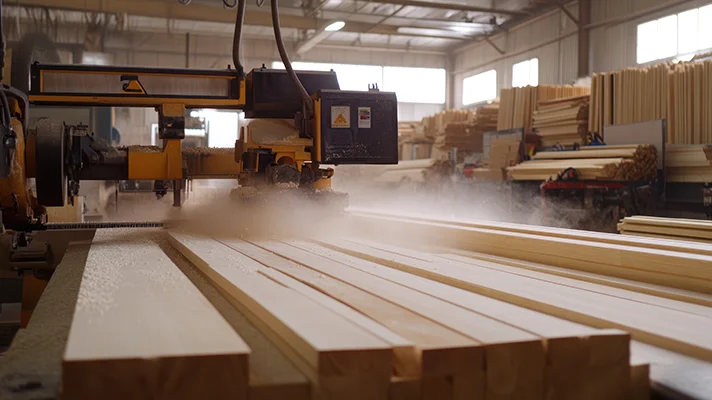Secure your future today!
Woodworking Operations - Fire and Dust Explosion Hazards

Woodworking businesses can operate for years without realizing that the risk for a catastrophic fire or explosion is building every day. Wood dust presents a high fire or explosion severity that can endanger employees, severely damage buildings, or interrupt customer service. Evaluate your hazards now and don’t wait until after a serious accident occurs. Basic and practical practices reduce the risk for a fire, or even a dust explosion and protect people and operations.
Although all wood waste products present a high fire risk, fine dry suspended dust increases the risk for an explosion. Most catastrophic dust explosions begin as small fires or explosions that disrupt a smaller amount of dust on flat surfaces, which in turn suspends in the air and is than ignited, resulting in a much larger explosion. Address these key areas to reduce the fire and explosion risk:
Control ignition sources
Control dust build up through good housekeeping practices
Collect dust using effective dust collection systems and methods
When required install spark detection equipment, suppression systems, or abort gates.
Control of Ignition Sources
Evaluate all phases of the operation to identify and properly address potential ignition sources. Consider and evaluate the following sources in your operation:
- Electrical: Areas where combustible dusts are generated require dust tight motors, electrical boxes, and controls. A licensed electrician should evaluate wiring and follow the National Electrical Code. Limit extension cord use and install permanent wiring for fixed equipment.
- Maintenance: Belts can cause friction and motors can overheat and ignite dust. A maintenance program should be in place to maintain equipment and replace worn belts. This also reduces downtime caused by equipment breakdown.
- Tramp metal: Evaluate areas where metal parts, nails, or staples are used for assembly and make sure that they don’t accidentally enter dust collection systems where friction against the metal duct can cause them to heat in ductwork and be carried to the dust collector.
- Hot work: Follow a formal hot work permit policy for any maintenance work that involves welding, grinding, or cutting metal outside of controlled areas. This includes removing combustible material, control of sparks, fire extinguishers, and a fire watch. Hastings Insurance can provide a formal hot work permit and program.
- Other sources: Don’t forget other potential ignition sources which can include flammable liquids, stain-soaked rags, smoking, static electricity, or extension cord use.
Dust Control
Housekeeping is critical as many fires and dust explosions start with a small spark and explosion that triggers a series of larger explosions as dust is displaced into the air. Evaluate the following areas:
- Preventative maintenance programs are needed to clean flat surfaces and equipment. As a general rule, dust is too thick if the surface or substrate cannot be seen. Other rules include 1/8” or dime thickness and surfaces that can’t be seen should be cleaned.
- Dust can build on handing light fixtures that produce higher heat, like florescent and halogen lights. Keep these light fixtures clean and free of dust.
- Dust accumulates on overhead flat surfaces and can become suspended in a cloud. Overhead fixtures, ductwork, beams, flat surfaces or hidden space are places where dust can accumulate and should be vacuumed.
- Implement scheduled clean up at the end of each shift with more detailed cleaning at other times. Vacuum dust and avoid sweeping or blowing dust off flat surfaces where fine particles can become suspended in the air.
- If dust accumulates quickly, inspect the dust collection system and correct problems.
- Rags that are soaked with solvents, stain, or material that can spontaneously ignite must be placed in Underwriter Laboratory listed metal containers with self-closing lids.
Dust Collection
An efficient system will collect dust, have tight seams, and convey into the collector without building up in the duct. Licensed mechanical contractors should be used to design proper dust collection systems that follow National Fire Protection Association (NFPA) guidelines.
Collection bins and bag houses should be located outside the building whenever possible and any dust collectors or bags that are located inside must meet NFPA requirements based on the system size and protection. General rules for all dust collection systems include:
- Keep seams tight and in duct in good condition to prevent dust from escaping and maintain
the proper air flow. - Keep motors and equipment in good condition to maintain the proper air flow.
- Inspect and clean the duct and all components of the dust collection system per manufacturer requirement to reduce dust buildup and maintain proper air flow.
- Metal that enters a dust collection system can heat as it passes through the duct and ignite dust; therefore, staples, nails, or other small metal parts must be kept out of all systems.
- Metal detectors or magnets are required for operations like wood hogs, chippers, or other processes where metal parts are a risk. Detectors should be installed upstream between equipment and dust collectors and interlocked to shut down the flow of material.
Flammable Liquids and Spray Finishing
If stains or paints are sprayed in a booth or open areas, then the booth or spray area must meet National Fire Protection Association (NFPA) 33 Standard for Spray Application Using Flammable or Combustible Materials. Proper controls include booth construction, fire suppression, ventilation, and control of ignition sources. Properly ground spray equipment and metal storage containers to reduce the risk for a spark from static electricity to ignite vapors.
Storage cabinets contain spilled liquids and help to keep the liquids from contributing fuel if a fire were to occur in the building. Flammable liquids containers must be stored in Underwriter Laboratory listed storage cabinets or rooms and storage must meet NFPA 30 Flammable and Combustible Liquid Code.
Fire Suppression and Spark Detection Systems
Fire protection systems can control fires that start, arrest sparks, or redirect smoke and explosive
pressure away from the building. These systems include:
- Spark arrestors that identify and control sparks in ductwork before they ignite dust.
- Automatic sprinkler systems or engineered suppression systems that control or extinguish fires in dust collectors.
- Extinguishing systems for high hazard operations can detect and suppress explosions in the earliest stages.
- High speed abort gates that close when a fire is detected so that heat and smoke don’t reenter a building.
Equipment with a history of producing sparks should have a suppression system or a spark detection system that follows NFPA requirements. According to NFPA, sources that produce higher levels of dust can include large belt sanders and planers having automatic feed systems, hammermills, pulverizers, and flakers. Protection also deserves consideration on dust collection systems for less hazardous equipment (e.g., saws) if the loss potential for occupant injury, property damage or interruption to production is high. Consult with a licensed mechanical contractor or fire suppression contractor to determine if the dust collection system requires a fire suppression system.
Many operations have dust collection systems that return air to the interior of the building after it passes through the outside dust collection system. Many fires being in the outside dust collector, and smoke or flames can enter the building through the return ductwork, which endangers occupants and can spread the fire to the building interior.
High speed abort gates are installed in ductwork and close when a fire is detected to redirect prevent hot air, flame, or smoke from an outside dust collection fire from re-entering the building. Abort gates should be installed for larger dust collection systems where air is recirculated into the plant. This is based on the amount of dust that is produced and can include four or more significant machines.
Standards and Guidelines
Key National Fire Protection Associations standards to follow include, but not limited to:
- NFPA 654 (Prevention of Fire and Dust Explosions from the Manufacturing, Processing, and Handling of Combustible Particulate Solids)
- NFPA 664 (Wood Processing and Woodworking Facilities)
- NFPA 13 Standard for the Installation of Sprinkler Systems
- NFPA 30 Flammable and Combustible Liquid Code.
- NFPA 33 Standard for Spray Application Using Flammable or Combustible Materials
- NFPA 70 National Electrical Code
Address these key areas to reduce the fire and explosion risk:
- Control ignition sources
- Control dust through good housekeeping practices
- Collect dust using effective dust collection systems and methods
- When required install detection, suppression, and abort gate systems
Download This Article
Additional Safety Topics
Check Out All Our Products
Commercial Insurance Built for You
We offer a wide range of Commercial insurance products. Find the product that's right for you!
Specialty Insurance
Commercial Auto Insurance Workers' Compensation Insurance Manufacturing Insurance Insurance for WineriesConstruction and Contracting
General Contractor Insurance Carpenters Insurance Plumbing Insurance Excavator Insurance Electrician Insurance HVAC Business Insurance Lawn Care Business InsuranceRetail and Service
Retail Business Insurance Barber Insurance Pet Grooming Insurance Florist Insurance Bakery Insurance Photographer Insurance Beautician Insurance Coffee Shop Insurance Funeral Home Insurance Janitorial InsuranceGet Insurance for Your Car and Home
You need to protect more than just your business. Get insurance for your personal property too!
Personal Lines InsuranceWe've Got You Covered!
We offer Personal Lines Insurance in five states: Ohio, Michigan, Illinois, Indiana, and Wisconsin.
Insurance for All Types of Farms
Hastings offers a range of products specifically designed for farmers.
Farm InsuranceWe've Got You Covered!
We offer Farm Lines Insurance in five states: Ohio, Michigan, Illinois, Indiana, and Wisconsin.
Secure your future today!
Hastings Insurance Company
404 E. Woodlawn Ave.
Hastings, MI 49058
Monday-Friday
8:00 a.m. - 4:30 p.m. (EST)
(800) 442-8277
Terms of Use and Privacy Statement© Hastings Insurance Company. All rights reserved.



